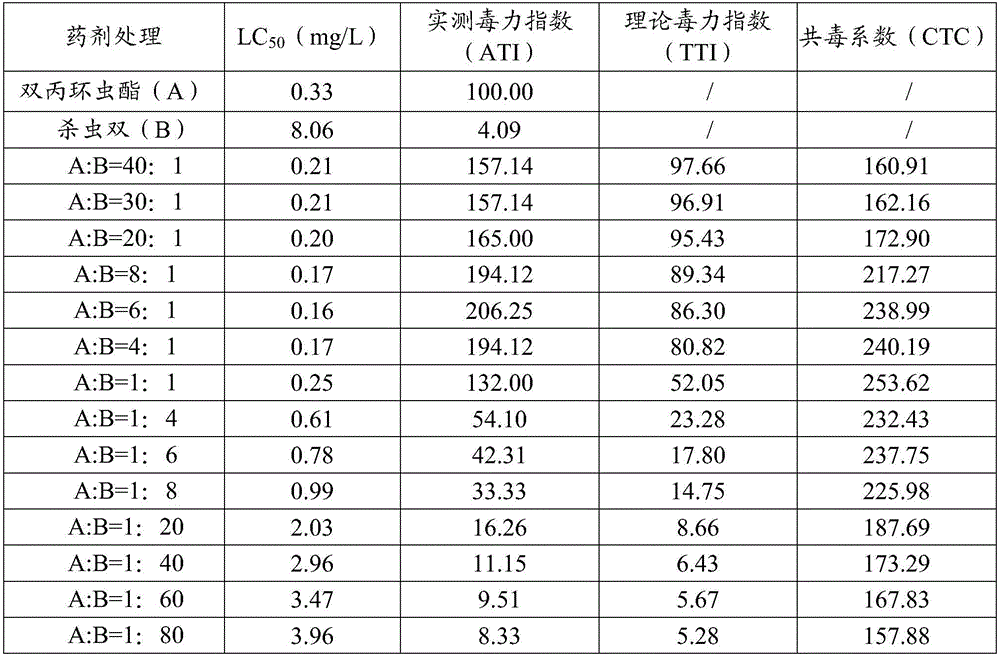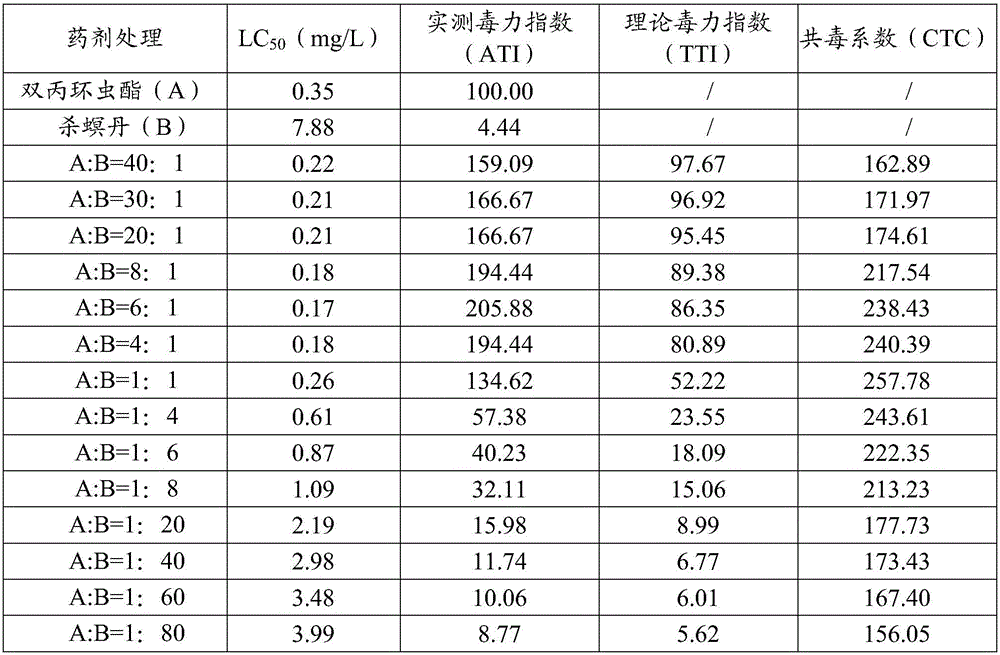Synergistic insecticidal composite containing afidopyropen
An insecticidal composition, a technology of diprocycline, applied in the directions of insecticides, biocides, biocides, etc., can solve problems such as no reports, and achieve reduction of field drug dosage, use cost, and effect position. The effect of increasing the point and increasing the efficacy of the medicine
- Summary
- Abstract
- Description
- Claims
- Application Information
AI Technical Summary
Problems solved by technology
Method used
Image
Examples
Embodiment 1
[0017] Biological Assay Example 1: Indoor Combined Toxicity Test of Dipropyrate and Dimehytap on Rice Planthoppers
[0018] Test object: Brown planthopper (Nilaparvata lugens (Stdl)), artificially reared indoors for multiple generations.
[0019] Test method: The test method refers to the "People's Republic of China Agricultural Industry Standard NY / T1154.11-2008". The rice stem dipping method is used: pull out the strong rice plants at the end of tillering stage, wash them, cut them into 15cm long rice stems with roots, and put them in a group of 4, and dry them in a cool place until there is no water mark on the surface. Soak the rice stems in the diluted medicament for 30 seconds, take them out and dry them, hold the roots with soaked absorbent cotton and put them in a petri dish, absorb the 3rd instar mid-stage nymphs and put them in a petri dish, 25 per cup, set Soaking in clear water was used as blank control, and each concentration was repeated 4 times. After treatmen...
Embodiment 2
[0028] Biological Assay Example 2: Indoor Combined Toxicity Determination Test of Dipropacyclopyrid and Monosultap on Rice Brown Planthopper
[0029] Test object: small planthopper (Laodelphax striatellus (Stdl)), artificially reared indoors for ten generations.
[0030] Test method: The test method refers to the "People's Republic of China Agricultural Industry Standard NY / T1154.11-2008". The rice stem dipping method is used: pull out the strong rice plants at the end of tillering stage, wash them, cut them into 15cm long rice stems with roots, and put them in a group of 4, and dry them in a cool place until there is no water mark on the surface. Soak the rice stems in the diluted medicament for 30 seconds, take them out and dry them, hold the roots with soaked absorbent cotton and put them in a petri dish, absorb the 3rd instar mid-stage nymphs and put them in a petri dish, 25 per cup, set Soaking in clear water was used as blank control, and each concentration was repeated...
Embodiment 3
[0035] Biological Assay Example 3: Indoor Combined Toxicity Test of Dipropacyclopyrene and Cartap Compound on Thrips
[0036] Test object: western flower thrips (Frankliniella occidentalis), cucumber seedlings were reared artificially for eight generations in an incubator.
[0037] Test method: The test refers to the "People's Republic of China Agricultural Industry Standard NY / T 1154.14-2008" and uses the leaf soaking method for determination. Soak the cabbage leaves (3㎝×4㎝) prepared in advance in the liquid medicine for 10 seconds, take them out and dry them naturally until there are no water marks on the surface, pick the 3rd instar nymphs of Thrips occidentalis with a brush, and remove the test insects To (25±1) ℃, 14 / 10 (L / D), relative humidity 70% in the greenhouse for normal cultivation. Each treatment was repeated 3 times, with 30 test insects per repetition.
[0038] The statistical analysis method is the same as in the biological assay example 1, and the toxicity a...
PUM
| Property | Measurement | Unit |
|---|---|---|
| Particle size | aaaaa | aaaaa |
Abstract
Description
Claims
Application Information
 Login to View More
Login to View More - R&D
- Intellectual Property
- Life Sciences
- Materials
- Tech Scout
- Unparalleled Data Quality
- Higher Quality Content
- 60% Fewer Hallucinations
Browse by: Latest US Patents, China's latest patents, Technical Efficacy Thesaurus, Application Domain, Technology Topic, Popular Technical Reports.
© 2025 PatSnap. All rights reserved.Legal|Privacy policy|Modern Slavery Act Transparency Statement|Sitemap|About US| Contact US: help@patsnap.com



